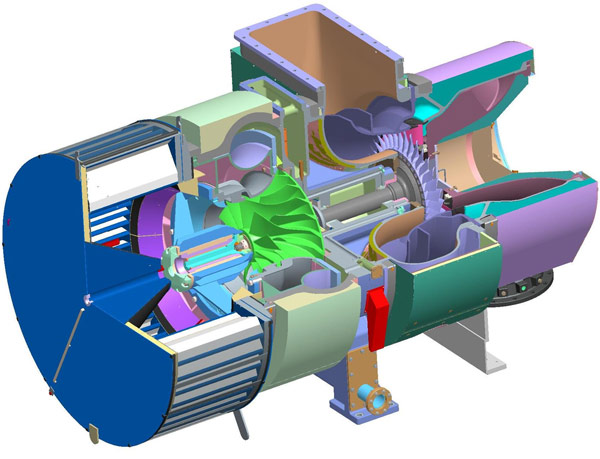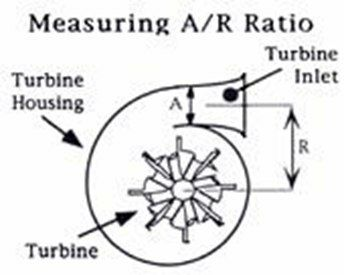
There are different acronyms that are generally used when referring to turbochargers with variable geometry turbines. In almost all cases these are or have been logo that the particular manufacturer has used with reference to their product. In more common usage, a particular acronym can be used in a more general sense and not necessarily be a reference to a particular manufacturer’s product. Some of these acronyms include:
VGT—Variable Geometry Turbocharger (Cummins/Holset),
VNT—Variable Nozzle Turbine (Honeywell/Garrett),
VTG—Variable Turbine Geometry (BorgWarner and ABB)
VG—Variable Geometry turbocharger (MHI)
VGS—Variable Geometry System turbocharger (IHI)
VTA—Variable Turbine Area (MAN Diesel & Turbo)
In many designs, a variable geometry turbine doesn’t cover a bypass so the turbine should be capable of handling all of the exhaust flow from the engine while avoiding overboost & overspeeding the turbocharger.
In contrast to the fixed geometry turbine, the variable geometry turbine permit significant flexibility over the pressure ratio/flow relationship across the turbine & by the extension, the engine ΔP. This flexibility can be used for enhancing low speed torque characteristics, reducing turbocharger lag.
Variable turbine area technology
Both TCA and TCR series turbochargers are available optionally with VTA technology, whereby a nozzle ring equipped with adjustable vanes replaces the fixed vane ring used in the standard turbochargers.
Adjusting the vane pitch regulates the pressure of the exhaust gases impinging on the turbine, thus enabling the compressor output to be varied and optimized at all points on the engine’s performance map.
The quantity of the charge air can be more exactly matched to the quantity of the fuel injected, stimulating reduced specific fuel consumption & emissions along with improved dynamic behaviour of the engine turbocharger system.
To reduce the thermal hysteresis & enhance adjustment accuracy, each vane have lever directly linked to the control ring, which is actuated by an electric positional motor with integrated reduction gear.
Control of the vane position is fully electronic, with feedback or open-loop control featuring mapped vane adjustment.
A complete range of control signals can be used, including charge air pressure after the compressor & exhaust gas temperature before & after the turbocharger.
Control packages can thus be altered precisely to the specific application, whether that demand mechanically controlled engines or engines with electronic management.
VTA adjustable vanes are manufactured from the heat & erosion resistant steel alloy. Precise selection of fits & materials is made to assure system working under all conditions without sticking, particularly in applications on the engines using heavy fuel oil.
Shop tests and shipboard trials with VTA equipped turbochargers have reportedly shows the expected enhancements at the part load in terms of fuel economy, decreased emissions of soot & unburnt hydrocarbons, & improved engine response under load changes. Lesser specific fuel oil consumption, enhanced torque & engine acceleration, lower combustion chamber temperatures & savings in electrical power to run the auxiliary blowers are among the benefits cited from the higher scavenging pressures in part-load operation.
Retrofits to prevailing turbochargers will be enabled by the MAN Diesel supplying complete packages for such projects, including the VTA nozzle ring, the actuator & the control system.
Variable Turbine Geometry
In the mid 1990s, evolution in the diesel & gas engine markets led to the TPS turbocharger version with the VTG.
One reason was the increasing popularity of single pipe exhaust systems for the diesel engines. When traditional turbochargers are used with these systems, part load operation tends to be difficult, load response is poor & smoke & particle emissions can be high. Gas engine performance had also enhanced impressively due to the increased efficiency & bmeps, high altitude capability & controlled air-to-fuel ratios.
It was not possible, but, to simply use conventional turbochargers with these engines. Solutions ranged from fitting a wastegate or throttle mechanism to special matching of the turbocharger, but each had its disadvantages.
An ‘adjustable’ turbocharger was considered the ideal solution for the candidate diesel & gas engines. Apart from eliminating the losses associated with the wastegate, a turbocharger equipped with VTG is more flexible in applications with changing operating or ambient conditions. Precise control of the air-to-fuel ratio (so-called Lamda regulation) is achieved with an innovative nozzle ring that enables the effective turbine area to be altered without any remarkable drop in the turbine efficiency. The clearances for the movable nozzle blade are reduced almost to zero by springs that push the blades against the opposing casing wall. Numerous VTG turbochargers have been supplied for Bergen gas engines specified for land-based power plants. ABB provides the VTG nozzle ring as an option for the TPS turbochargers (frame sizes 57 through 61), TPL65-A turbochargers & the new A100 series serving diesel & gas engines but aim at the wider application of the technology.
Accurate alteration of engine operation to actual working requirements is enabled over a wide range of ambient conditions. Part load operation, load acceptance & engine emission levels can all be optimized by regulated rotation of the movable nozzle ring vanes.
Measuring A/R ratio

AR is the ratio of the area of the cone to the radius from the center hub.
If you were to calculate the cross section on any point on the turbo & divide by the distance from the center of that cross section to the center of the turbine wheel, you would get AR ratio.
Preferably, this ratio should remain the same as you move in & out of the turbo housing because the housing gets smaller as you get closer to the center.
aspect ratio dynamically changed for VTA and VGT turbochargers as per load




